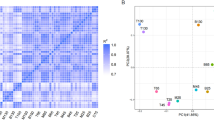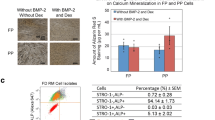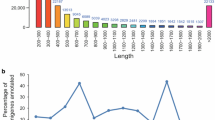Abstract
Deer antlers are the only mammalian appendages capable of repeated rounds of regeneration. Every year, deer antlers are shed and regrown from blastema into large branched structures of cartilage and bone. Little is known about the genes involved in antler development particularly during the later stages of ossification. We have produced more than 39 million sequencing reads in a single run using the Illumina sequencing platform. These were assembled into 138,642 unique sequences (mean size: 405 bp) representing 50 times the number of Sika deer sequences previously available in the NCBI database (as of Nov 2, 2011). Based on a similarity search of a database of known proteins, we identified 43,937 sequences with a cut-off E-value of 10−5. Assembled sequences were annotated using Gene Ontology terms, Clusters of Orthologous Groups classifications and Kyoto Encyclopedia of Genes and Genomes pathways. A number of highly expressed genes involved in the regulation of Sika deer antler ossification, including growth factors, transcription factors and extracellular matrix components were found. This is the most comprehensive sequence resource available for the deer antler and provides a basis for the molecular genetics and functional genomics of deer antler.


Similar content being viewed by others
References
Aszodi A, Hunziker EB, Brakebusch C et al (2003) β1 integrins regulate chondrocyte rotation, G1 progression, and cytokinesis. Gene Dev 17:2465–2479
Benedetto AD, Watkins M, Grimston S et al (2010) N-cadherin and cadherin 11 modulate postnatal bone growth and osteoblast differentiation by distinct mechanisms. J Cell Sci 123:2640–2648
Chen FH, Herndon ME, Patel N et al (2007) Interaction of cartilage oligomeric matrix protein/thrombospondin 5 with aggrecan. J Biol Chem 282:24591–24598
Conesa A, Götz S, García-Gómez JM et al (2005) Blast2GO: a universal tool for annotation, visualization and analysis in functional genomics research. Bioinformatics 21:3674–3676
Deák F, Mátés L, Krysan K et al (1999) Characterization and chromosome location of the mouse link protein gene (Crtl1). Cytogenet Cell Genet 87:75–79
Eyre D (2002) Collagen of articular cartilage. Arthritis Res 4:30–35
Hale JE, Fraser JD, Price PA (1988) The identification of matrix Gla protein in cartilage. J Biol Chem 263:5820–5824
Harris MA, Clark J, Ireland A et al (2004) The gene ontology (GO) database and informatics resource. Nucleic Acids Res 32:D258–D261
Hartmann C (2009) Transcriptional networks controlling skeletal development. Curr Opin Genet Dev 19:437–443
Hinoi E, Bialek P, Chen YT et al (2006) Runx2 inhibits chondrocyte proliferation and hypertrophy through its expression in the perichondrium. Gene Dev 20:2937–2942
Iseli C, Jongeneel CV, Bucher P (1999) ESTScan: a program for detecting, evaluating, and reconstructing potential coding regions in EST sequences. Proc Int Conf Intell Syst Mol Biol 138–148
Ivkovic S (2003) Connective tissue growth factor coordinates chondrogenesis and angiogenesis during skeletal development. Development 130:2779–2791
Izu Y, Sun M, Zwolanek D et al (2011) Type XII collagen regulates osteoblast polarity and communication during bone formation. J Cell Biol 193:1115–1130
Kanehisa M, Goto S, Kawashima S et al (2004) The KEGG resource for deciphering the genome. Nucleic Acids Res 32:D277–D280
Kirsch T, Von der Mark K (1992) Remodelling of collagen types I, II and X and calcification of human fetal cartilage. Bone Miner 18:107–117
Kong L, Tian Q, Guo F et al (2010) Interaction between cartilage oligomeric matrix protein and extracellular matrix protein 1 mediates endochondral bone growth. Matrix Biol 29:276–286
Lee Y, Tsai J, Sunkara S et al (2005) The TIGR gene indices: clustering and assembling EST and known genes and integration with eukaryotic genomes. Nucleic Acids Res 33:D71–D74
Li C, Suttie JM (1994) Light microscopic studies of pedicle and early first antler development in red deer (Cervus elaphus). Anat Rec 239:198–215
Li TF, O’Keefe RJ, Chen D (2005) TGF-β signaling in chondrocytes. Front Biosci 10:681–688
Li C, Yang F, Sheppard A (2009) Adult stem cells and mammalian epimorphic regeneration-insights from studying annual renewal of deer antlers. Curr Stem Cell Res Ther 4:237–251
Li R, Zhu H, Ruan J et al (2010) De novo assembly of human genomes with massively parallel short read sequencing. Genome Res 20:265–272
Livak KJ, Schmittgen TD (2001) Analysis of relative gene expression data using real-time quantitative PCR and the 2−ΔΔct Method. Methods 25(4):402–408
Mackie EJ, Ahmed YA, Tatarczuch L et al (2008) Endochondral ossification: how cartilage is converted into bone in the developing skeleton. Int J Biochem Cell B 40:46–62
Mak KK, Kronenberg HM, Chuang PT et al (2008) Indian hedgehog signals independently of PTHrP to promote chondrocyte hypertrophy. Development 135:1947–1956
Matsuo K, Irie N (2008) Osteoclast–osteoblast communication. Arch Biochem Biophys 473:201–209
Matsusaki T, Aoyama T, Nishijo K et al (2006) Expression of the cadherin-11 gene is a discriminative factor between articular and growth plate chondrocytes. Osteoarthr Cartil 14:353–366
Metzker ML (2009) Sequencing technologies–the next generation. Nat Rev Genet 11:31–46
Morello R, Bertin TK, Chen Y et al (2006) CRTAP is required for prolyl 3- hydroxylation and mutations cause recessive osteogenesis imperfecta. Cell 127:291–304
Mortazavi A, Williams BA, Mccue K et al (2008) Mapping and quantifying mammalian transcriptomes by RNA-Seq. Nat Methods 5:1–8
Nakajima A, Shimizu S, Moriya H et al (2003) Expression of fibroblast growth factor receptor-3 (FGFR3), signal transducer and activator of transcription-1, and cyclin-dependent kinase inhibitor p21 during endochondral ossification: differential role of FGFR3 in skeletal development and fracture repair. Endocrinology 144:4659–4668
Newman B, Gigout LI, Sudre L (2001) Coordinated expression of matrix Gla protein is required during endochondral ossification for chondrocyte survival. J Cell Biol 154:659–666
Niyibizi C, Eyre DR (1994) Structural characteristics of cross-linking sites in type V collagen of bone. Chain specificities and heterotypic links to type I collagen. Eur J Biochem 224:943–950
Ortega N, Behonick DJ, Werb Z (2004) Matrix remodeling during endochondral ossification. Trends Cell Biol 14:86–93
Price J, Allen S (2004) Exploring the mechanisms regulating regeneration of deer antlers. Phil Trans R Soc Lond B Biol Sci 359:809–822
Price PA, Williamson MK (1985) Primary structure of bovine matrix Gla protein, a new vitamin K-dependent bone protein. J Biol Chem 260:14971–14975
Schroeder A, Mueller O, Stocker S et al (2006) The RIN: an RNA integrity number for assigning integrity values to RNA measurements. BMC Mol Biol 7:3
Shi CY, Yang H, Wei CL et al (2011) Deep sequencing of the Camellia sinensis transcriptome revealed candidate genes for major metabolic pathways of tea-specific compounds. BMC Genomics 12:131
Szuwart T, Kierdorf H, Kierdorf U et al (2002) Histochemical and ultrastructural studies of cartilage resorption and acid phosphatase activity during antler growth in fallow deer (Dama dama). Anat Rec 268:66–72
Tatusov RL, Natale DA, Garkavtsev IV et al (2001) The COG database: new developments in phylogenetic classification of proteins from complete genomes. Nucleic Acids Res 29:22–28
Trackman PC (2005) Diverse biological functions of extracellular collagen processing enzymes. J Cell Biochem 96:927–937
von der Mark K, von der Mark H (1977) The role of three genetically distinct collagen types in endochondral ossification and calcification of cartilage. J Bone Joint Surg Br 59B:458–464
Wang Z, Gerstein M, Snyder M (2009) RNA-Seq: a revolutionary tool for transcriptomics. Nat Rev Genet 10:57–63
Wang XW, Luan JB, Li JM et al (2010) De novo characterization of a whitefly transcriptome and analysis of its gene expression during development. BMC Genomics 11:400
Wenstrup RJ, Florer JB, Brunskill EW et al (2004) Type V collagen controls the initiation of collagen fibril assembly. J Biol Chem 279:53331–53337
Ye J, Fang L, Zheng H et al (2006) WEGO: a web tool for plotting GO annotations. Nucleic Acids Res 34(Web Server issue):W293–W297
Yoshida CA, Yamamoto H, Fujita T et al (2004) Runx2 and Runx3 are essential for chondrocyte maturation, and Runx2 regulates limb growth through induction of Indian hedgehog. Gene Dev 18:952–963
Zheng Q, Zhou G, Morello R et al (2003) Type X collagen gene regulation by Runx2 contributes directly to its hypertrophic chondrocyte-specific expression in vivo. J Cell Biol 162:833–842
Acknowledgments
This work was supported by the National Key Technology Research and Development Program of the Ministry of Science and Technology of China (Grant No. 2011BAI03B00) and by the National Science and Technology Major Project of the Ministry of Science and Technology of China (Grant No. 2011ZX09401-305-09).
Author information
Authors and Affiliations
Corresponding authors
Electronic supplementary material
Below is the link to the electronic supplementary material.
10529_2011_841_MOESM1_ESM.pdf
Fig. S1 Graph of de novo assembly results at different k-mer sizes. The x-axis indicates different k-mer sizes. The y-axis indicates the number of assembly sequences under different k-mer sizes. (PDF 3174 kb)
10529_2011_841_MOESM2_ESM.pdf
Fig. S2 Ratio distribution of the gap’s length to the length of assembled unigenes. The x-axis indicates the ratio of the gap’s length to the length of assembled unigenes. The y-axis indicates the number of unigenes containing gaps. (PDF 1117 kb)
10529_2011_841_MOESM3_ESM.pdf
Fig. S3 Random distribution of Illumina sequencing reads in the assembled unigenes. The x-axis indicates the relative position of sequencing reads in the assembled unigenes. The orientation of unigene is from 5′ end to 3′ end. (PDF 2325 kb)
10529_2011_841_MOESM4_ESM.pdf
Fig. S4 Validation of candidate genes in Sika deer transcriptome by qPCR. The left y-axis indicates the relative abundance of candidate genes in Sika deer antler resulting from qPCR. The right y-axis indicates gene expression levels of candidate genes according to RPKM calculation. (PDF 3306 kb)
Rights and permissions
About this article
Cite this article
Yao, B., Zhao, Y., Zhang, H. et al. Sequencing and de novo analysis of the Chinese Sika deer antler-tip transcriptome during the ossification stage using Illumina RNA-Seq technology. Biotechnol Lett 34, 813–822 (2012). https://doi.org/10.1007/s10529-011-0841-z
Received:
Accepted:
Published:
Issue Date:
DOI: https://doi.org/10.1007/s10529-011-0841-z




